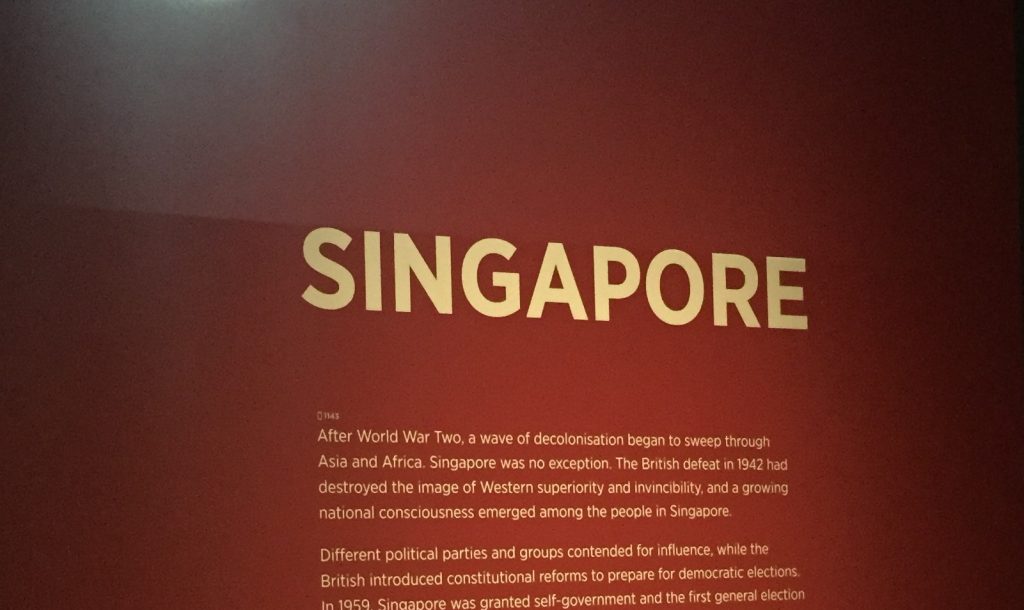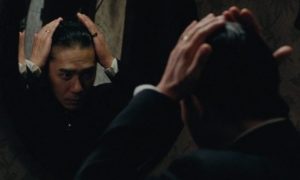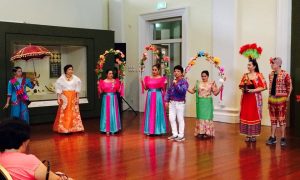The Singapore History Gallery at the National Museum of Singapore is, like any other historical exhibition, carefully staged. The production of such a place, or more accurately, the production of the experience of such a place, requires the expertise of dramatists, storytellers, scriptwriters, lighting, sound and set designers, and even actors, as Mark Ravinder Frost reveals in his evocative and personal account of what it took to “make history alive” in the Gallery. Since that account (published in 2009), the Gallery has predictably undergone major changes – nothing stands still in Singapore for long. This is especially because of Singapore’s golden jubilee in 2015 (known locally as SG50), which spurred numerous nation-wide historical initiatives from top-down and bottom-up (and the fuzzy in-between), prompted by an overdue desire to catch up to our past in the same relentless way we have pursued, and are continuing to pursue, our future, ad infinitum.
The Gallery’s “larger concern was to generate, in an audience bored by national history, an excitement about the past,” states Frost. That is not, however, to suggest that museum-goers like me are passive receptors of the edu-taining stories that exhibitions are designed to impart. In fact, as Sharon Macdonald (2003) observes, we are performers ourselves, navigating through the space with our bodies, and enacting our own experiences with every decision to turn our gaze to something, to trace an object or a sign with our fingertips, to stop and listen – or even to ignore, to walk away, and to disengage despite the many screaming curatorial attempts to convince visitors to please, please participate (Smell this! Sit here! Listen to this!; see below).
Singapore has been through many names; indeed, one challenge for historians of pre-colonial Singapore was to find out possible references to Singapore amongst the countless toponyms in classical Chinese, Arabic, Indian and Graeco-Roman texts about the Malay peninsula. As such, it is apt that the Gallery is organised according to what Singapore was called in various points in time: as Singapura, as the Crown Colony, as Syonan-To, and finally (at the risk of sounding teleological), as Singapore. This timeline is a visual reminder in every room of the Gallery, and appropriately colour-coded: a tropical green for forested Singapura, a royal blue for the colonial period, a grim black for the dark times of the Japanese Occupation, and a symbolic red for independent Singapore.
I enter the Gallery and come across a dimly lit cavern with the partial hull of a large wooden ship in the centre. There are sounds of crickets chirping and tropical bird-calls, with fishing traps strung across the ceiling and various woven baskets and clay pottery stacked neatly along the walls of the cavern. The light shining on artificial shrubbery casts dappled shadows on the ‘rainforest floor’. I am in Temasek-Singapura: five hundred years of history once regarded as “irretrievably lost in the mists of time” (S. Rajaratnam, 1984), but in recent years revisited and (always partially) reconstructed by archaeologists such as John Miksic and in Kwa Chong Guan’s primer, Pre-Colonial Singapore, published for SG50 (2017). Jarringly, amongst the three-dimensional trees and pottery, enormous wall-to-wall screens offer digital windows to what the flora might have been – complete with an audio-visual loop of actors posing as orang laut going about their daily lives. It’s an uncanny mix of the artificial and ‘real’ and back again, a virtual/reality so fundamental to the Singaporean aesthetic (think of Our Tampines Hub).
 I am inside the hull of the ship, where a portrait of Sir Stamford Raffles sits. Ah, the man on the ship that changed our destiny. I pause in front his panel, and its subheading reads, intriguingly, “Founder” of modern Singapore. The double quotation marks seem to signal our ambivalence towards this figure; we have until very recently persisted with a history that focussed on the role he played, partly to assure foreign investors during the turbulent post-independence days that we embody his values, and partly to ensure that a ‘neutral’ European figure would be our founder – to do otherwise would purportedly risk our delicate racial balance. At the same time, focussing on Raffles means that our history will always be Eurocentric, a problem Kwa attempted to rectify in Pre-Colonial Singapore. I contemplate briefly on the possible meanings of the quotation marks before moving on.
I am inside the hull of the ship, where a portrait of Sir Stamford Raffles sits. Ah, the man on the ship that changed our destiny. I pause in front his panel, and its subheading reads, intriguingly, “Founder” of modern Singapore. The double quotation marks seem to signal our ambivalence towards this figure; we have until very recently persisted with a history that focussed on the role he played, partly to assure foreign investors during the turbulent post-independence days that we embody his values, and partly to ensure that a ‘neutral’ European figure would be our founder – to do otherwise would purportedly risk our delicate racial balance. At the same time, focussing on Raffles means that our history will always be Eurocentric, a problem Kwa attempted to rectify in Pre-Colonial Singapore. I contemplate briefly on the possible meanings of the quotation marks before moving on.
Allow me, in the limited space of this blog post, to fast forward my visit to the period of post-war Singapore, at the cusp of merger with Malaya. There is an incessant beeping sound in the background, like a fire alarm, and it adds to the sense of urgency as I am faced with an overload of black-and-white footage of rallies and riots, images of Singapore unimaginable in today’s context. There are oral history interviews of said rallies and riots listenable through earpieces connected to the wall, but only one voice is heard above the fray, no earpieces necessary: that of our first Prime Minister Lee Kuan Yew heralding a “new era” for Singaporeans. Indeed, in the entire gallery his is the only voice that one has no choice but to hear. It doesn’t matter that the podium where he made his inaugural speech as Prime Minister is empty.
The rooms after this one deal with the period after 1963 in quick, dizzying succession, with none of the languid pace that seemed to dictate the years before. The ‘60s, ‘70s, ‘80s, ‘90s and 2000s fly by, as if the rate of change makes it impossible for one to dwell, as if we are, endlessly, sprinting to ‘The Next Lap‘. Our industrial period in particular is characterised mostly by one bizarre room, which, with its bright white light, is a stark contrast to the dim yellow or the turbulent red from before. This fluorescence is augmented by the reflective surfaces of the metal floors, steel tables, and most curiously, the mirrored walls. I listen to an oral history interview of factory workers from the 1970s as I stare at my own reflection and the infinite number of bland metal tables reflected behind me. Somehow I doubt this design is a Marxist critique of the means of (re)production. I can’t help but think of the unkind stereotype of the robotic, factory-made Singaporean.
I am spat out to the other side, the end point of my journey. The beginning and the end are, obviously, night and day. Tropical flora is replaced by trees with screens on them, crickets become a funky electric keyboard refrain. The circle of raised artificial turf beckons at me to sit down and marvel at where we are today, as conveyed by the statistics on the wall. 
Someone has left the interactive timeline of Singapore, a panel available in almost every room, on the year “1640” – an amusing contrast.

The last thing you encounter before the exit could be out of a sci-fi movie, and is also the Gallery’s final call for participation: electronic panels rise from the floor, facing a virtual map of the world. On the macro-level, you can select a country, from Australia to Andorra, and you can see how Singapore is connected to it. On the micro-level, you can explore every neighbourhood of Singapore, see images and personal memories of particular places, and even add your own. The Gallery wants you to leave knowing we have become a Smart Nation and a Global City, but the individual memories of Singaporeans, rather than merely adding a nice personal touch, often carry a melancholic air to them that the exhibition has so far been able to avoid, revealing the price of development. “The Katong I knew […] has changed beyond recognition,” laments Adora Tan. As a fellow Katong resident of the same age, I know exactly what she means.
Mark Frost expressed frustration in his account of the production of the Singapore History Gallery that some museum visitors interpreted the lighting, the music, and other design elements in a certain way, when “the simple reality” was that some of these elements were constrained by technology or practical reasons (2009, 76). That may be the case, but I argue that the thing about going to museums is this: you have the power to make of it what you will, to create your own experiences and meanings atop the performance space the curators construct. Hence my interpretation of Adora’s lament as a lament, or my decision to turn every interactive timeline I saw to certain dates in 1963 and 1987 for others to see. Go forth and explore the Gallery, with all its fascinating nooks and crannies and endless possible meanings. To infinity and beyond!
The Singapore History Gallery at the National Museum of Singapore is free to all Singaporean citizens. All photographs are taken by the author.
 Facebook
Facebook  Twitter
Twitter  Soundcloud
Soundcloud  Youtube
Youtube  Rss
Rss 

